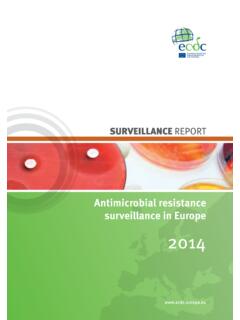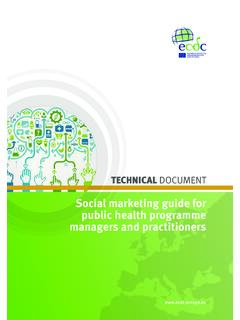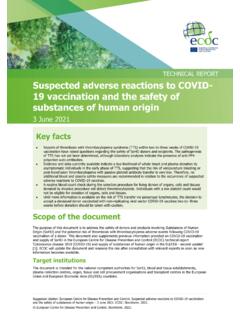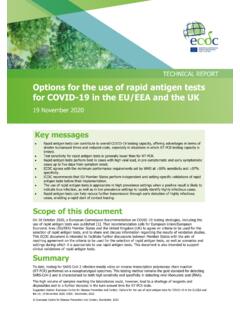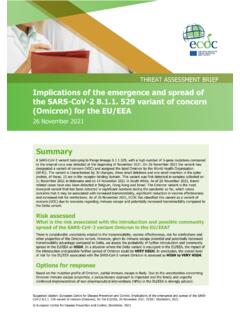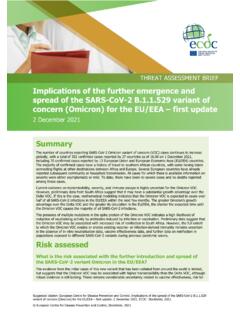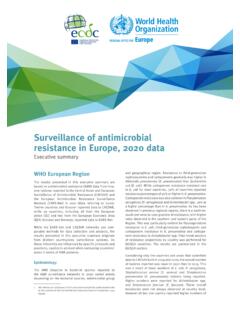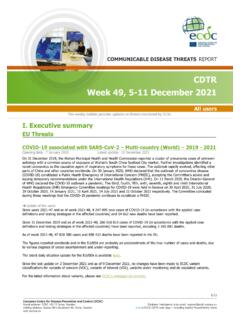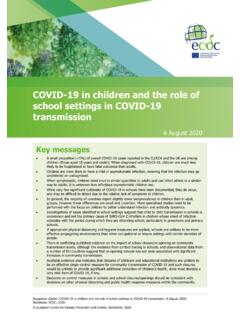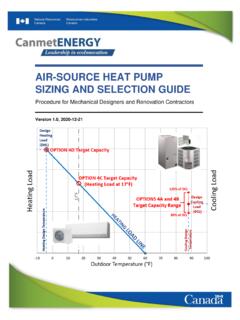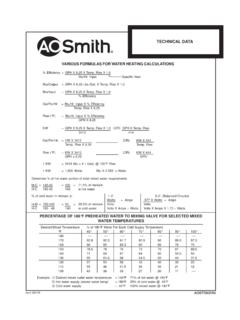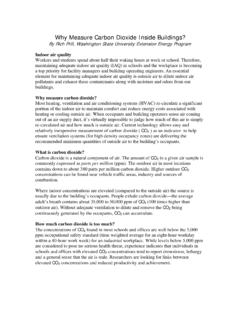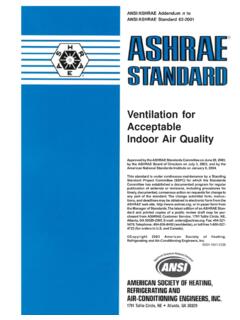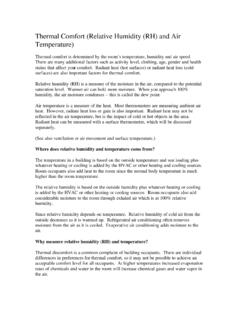Transcription of Heating, ventilation and air-conditioning systems in the ...
1 Suggested citation: European Centre for Disease Prevention and Control. heating , ventilation and air-conditioning systems in the context of COVID-19. 10 November 2020. Stockholm: ECDC; 2020. European Centre for Disease Prevention and Control, Stockholm, 2020. heating , ventilation and air-conditioning systems in the context of COVID-19: first update 10 November 2020 Key messages It is now well-established that COVID-19 transmission commonly occurs in closed spaces; If well-maintained and adapted for use in the COVID-19 pandemic, heating , ventilation and air-conditioning (HVAC) systems may have a complementary role in decreasing potential airborne transmission of SARS-CoV-2; Four bundles of non-pharmaceutical interventions (NPIs) should be considered to reduce potential airborne transmission of SARS-CoV-2 in closed spaces: the control of COVID-19 sources in closed spaces.
2 Engineering controls in mechanically ventilated (by HVAC systems ) and naturally ventilated closed spaces; administrative controls; and personal protective behaviour. Scope of this document This document provides guidance on heating , ventilation and air-conditioning (HVAC) systems in closed spaces in the context of the COVID-19 pandemic. Changes to the current update The first update of the ECDC ventilation guidance document contains: key new findings that emphasise four bundles of NPIs to reduce the risk of SARS-CoV-2 transmission in closed spaces; updated references on the evidence of transmission in closed spaces; recommendations based on the new evidence and on national and international guidance; and an overview of national guidance ventilation documents in the context of COVID-19 based on an inquiry sent to ECDC s National Focal Points (NFPs) for Preparedness and Response and NFPs for Influenza and other respiratory diseases.
3 Target audience Public health authorities in the European Union and European Economic Area (EU/EEA) and the United Kingdom (UK). ECDC heating , ventilation and air-conditioning systems in the context of COVID-19: first update 2 heating , ventilation and air-conditioning (HVAC) systems HVAC systems are used to provide comfortable environmental conditions (temperature and humidity) and clean air in indoor settings such as buildings and vehicles. HVAC systems can be configured in a variety of ways, depending on their application and the functions of the building or vehicle [1,2]. ventilation systems provide clean air by exchanging indoor and outdoor air and filtering. Air -conditioning systems can be part of integrated HVAC systems or stand-alone, providing air filtering and/or cooling/warming and dehumidification.
4 Stand-alone systems usually recirculate the air without mixing it with outdoor air. Poor ventilation in confined indoor spaces is associated with the increased transmission of respiratory tract infections such as influenza, tuberculosis and rhinovirus infection [3]. Similarly, SARS-CoV-2, there transmission is particularly effective in closed spaces, including from pre-symptomatic COVID-19 cases [4 -6]. Although the role of ventilation in preventing SARS -CoV-2 transmission is not currently well-defined ( by preventing the dispersal of infectious particles to minimise the risk of transmission or preventing the transfer of an infectious dose to susceptible individuals, it is thought to be primarily transmitted via large respiratory droplets; however, several reports point to aerosols playing a role in COVID-19 outbreaks [7 -13].)
5 Aerosols consist of small droplets and droplet nuclei that remain suspended in the air for longer than large droplets [14,15]. There is a debate in the scientific community over the long-standing terminology that defines droplets as having an average particle size 5 m and aerosols as having an average particle size <5 m [16,17]. Nonetheless, there is consensus that coughing, shouting, singing, and even speaking produce a mixture of both droplets and aerosols in a range of sizes [18]. Scientific groups have undertaken environmental investigations in hospital rooms in which COVID-19 patients were admitted and detected viral RNA in air samples and air outlet fans, therefore inferring the possibility of aerosols in those areas [19-23].
6 Two studies strongly suggest that transmission through aerosols probably occurs in closed spaces (short-range aerosol) in which many people stay for longer periods of time [11,13]. In two studies, low concentrations of cultivable SARS-CoV-2 were detected in air samples from a hospital room in which COVID-19 patients resided [11,13]. The relative roles of large droplet, aerosol and fomite transmission for SARS-CoV-2 and the transmissibility of the virus at different stages of the disease remain unclear. Studies indicate that SARS-CoV-2 particles can remain infectious on various materials, as well as in aerosols in indoor environments, with the duration of infectivity depending on temperature and humidity [24]. To date, transmission through fomites has not been documented, but it is considered possible.
7 Evidence for SARS-CoV-2 transmission in closed spaces and the role of HVAC systems SARS-CoV-2 transmission is particularly effective in crowded, confined indoor spaces such as workplaces (offices, factories) and other indoor settings, such as churches, restaurants, gatherings at ski resorts, parties, shopping centres, worker dormitories, dance classes, cruise ships and vehicles [25]. There are also indications that transmission can be linked to specific activities, such as singing in a choir [10] or during religious services characterised by the increased production of respiratory droplets and including aerosols through loud speech and singing. However, there is as yet no evidence of human infection with SARS-CoV-2 caused by air distributed through the ducts of HVAC systems [8].
8 In a study of 318 outbreaks in China, SARS-CoV-2 transmission occurred in indoor spaces in all but one of the outbreaks [12]. The only case of outdoor transmission identified in this study involved two people. However, outdoor events have also been implicated in the spread of COVID-19, typically those associated with crowds, such as carnival celebrations [26] and football matches [27], highlighting the risk of crowding even at outdoor events. Nevertheless, outdoor events often have adjacent closed spaces, such as bars, food areas and restrooms, which can be crowded. The length of time that people stay in indoor settings appears to be associated with the attack rate. For example, in a choir practice in Washington State in the United States, there were 32 confirmed and 20 probable secondary COVID-19 cases among 61 participants ( ) [10].
9 In an epidemiological investigation at a call centre in South Korea, there was an attack rate of among 216 employees on the ninth floor of the call centre, indicating extensive transmission in a crowded indoor workplace environment [28]. Nearly all the infected employees were sitting on the same side of the ninth floor, and there was no obvious relationshi p between the risk of transmission and the distance from the index case on this side of the floor. The authors also concluded that the length of time people were in contact played the most important role in the spreading of COVID-19, since the cases were limited almost exclusively to the ninth floor despite interactions with colleagues in other settings such as in elevators and in the lobby.
10 Several studies have addressed the role of ventilation in COVID-19 outbreaks. In a COVID-19 outbreak in a restaurant in Guangzhou, China, there were 10 cases across three families [29]. They developed symptoms between 26 January and 10 February 2020, having eaten lunch on 23 January at the same five-floor restaurant, ECDC heating , ventilation and air-conditioning systems in the context of COVID-19: first update 3 in which windows could not be opened and ventilation was only provided by the air-conditioning system. Their tables were more than one metre apart. The index case was pre-symptomatic and developed a fever and cough the same evening after leaving the restaurant. The secondary cases were sitting along the line of airflow generated by the air-conditioning system, while diners sitting elsewhere in the restaurant were not infected.
